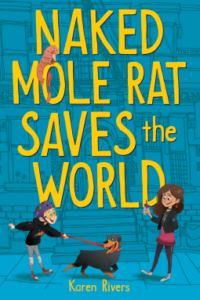
Naked Mole Rat Saves the World
Karen Rivers
Algonquin Young Readers
Available October 15, 2019
Amazon | Barnes & Noble | Book Depository | Goodreads
About Naked Mole Rat Saves the World
Can Kit’s super-weird superpower save her world?
Kit-with-a-small-k is navigating middle school with a really big, really strange secret: When she’s stressed, she turns into a naked mole rat.
It first happened after kit watched her best friend, Clem, fall and get hurt during an acrobatic performance on TV. Since then, the transformations keep happening—whether kit wants them to or not. Kit can’t tell Clem about it, because after the fall, Clem just hasn’t been herself. She’s sad and mad and gloomy, and keeping a secret of her own: the real reason she fell.
A year after the accident, kit and Clem still haven’t figured out how to deal with all the ways they have transformed—both inside and out. When their secrets come between them, the best friends get into a big fight. Somehow, kit has to save the day, but she doesn’t believe she can be that kind of hero. Turning into a naked mole rat isn’t really a superpower. Or is it?
My Review
Okay, so you’re probably thinking this book sounds weird. And it is a bit weird. But oh. My. Gosh. It’s layered. And complex. The characters face incredibly challenging things and have these really complicated, very believable (okay except for the changing into a naked mole rat part!) responses to those situations. I love both kit and Clem. Their friendship felt so real. So did kit’s troubling relationship with her mom.
One thing that was tough for me is that though the book has some characters dealing with mental health issues, there isn’t really anyone calling that out and offering help. Kit feels an incredible burden, but she doesn’t know where to turn and the only other adult regularly in her life encourages some enabling behavior rather than seeking help.
I know sometimes that’s really what happens. Sometimes there isn’t anyone really looking out for a person who’s barely treading water in the midst of anxiety or depression. This book made me want to find all the kids like kit and do something to help them. To provide them with better support.
Overall I totally love this book. The emotional journeys of kit and Clem gripped my heart. I love the way the friendships felt so organic and real. I love the way Clem’s grandma told awkward family stories and laughed at strange moments.
I think readers who enjoyed FLORA & ULYSSES will love NAKED MOLE RAT SAVES THE WORLD. It’s got a lot of the same kind of deep emotional wrestling and quirky departures from reality.
Content Notes
Recommended for Ages 10 up.
Representation
Clem is Latina and is depressed. Kit and her mom both have anxiety issues, and kit was born prematurely, so that she is still small for her age and has alopecia universalis, which causes her to have no hair.
Profanity/Crude Language Content
None.
Romance/Sexual Content
Clem’s twin brother has a crush on a girl which she teases him about.
Spiritual Content
One character learns about a relative who joined a cult and died by suicide with the whole group.
Violent Content
Some description of Clem’s accident which results in serious injuries. Brief descriptions of robbery. See above.
Drug Content
None.
Note: This post contains affiliate links, which do not cost you anything to use, but which help support the costs of running this blog. I received a free copy of NAKED MOLE RAT SAVES THE WORLD in exchange for my honest review.
About Karen Rivers
I was born, grew up, and currently live in British Columbia, where I take a lot of photos, walk a lot of paths, and write books for children, teens and adults.
The stories I tell are emotionally honest, but they aren’t about real people. Fiction has a way of telling the truth though, don’t you think?
I believe that readers are always asking the question, “Am I OK?” I write characters who suspect that they are not OK, but who eventually find inside themselves the strength to change that belief.
Growing up is harder than ever. The world is often egregiously unfair. Things can seem impossible.
How do we go on?
I believe in the power of stories. I think that stories will save us. They can show us the way.
Novels are magical. Books can be mirrors or windows. We sometimes need to see ourselves. We always need to understand others.
Stories are all secret passages to alternate worlds where we can be safe to explore the unsafe, the unsettling or the unfair hands some people have been dealt.
In the pages of a book, we can be braver than we are, we can go further than we’d normally dare, we can understand more than we know.
Books make us better, period.
I believe in magic. Do you?
Be brave. Be kind. And believe this: You are OK.
I believe in you.